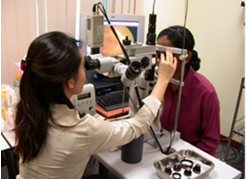Eye Laser Treatments
Laser treatments are done for a variety of different retinal diseases ranging from retinal tears and diabetic eye disease to age-related macular degeneration, etc. No hospitalization is necessary.

A patient having laser treatment done.
2 common forms of laser treatment are “hot laser” and “cold laser”. “Cold laser is also known as “photodynamic therapy / PDT”.
Hot laser treatment
This is commonly used for the treatment of retinal tears, diabetic retinopathy and some forms of age-related macular degeneration.
Laser beams are used to burn or destroy abnormal areas of the retina in diabetic retinopathy and age-related macular degeneration. In the case of retinal tears, the laser beam is applied to the margins of the tears to deliberately induce scarring in strategic areas in order to “seal” these retinal tears and prevent retinal detachments.
Hot laser treatment used to be time-consuming and uncomfortable but the modern semi-automated scanning laser system has made treatment much faster. In addition, this new laser system also causes little or no discomfort during treatment, and fewer side-effects.

The scanning laser system can deliver multiple laser shots simultaneously, making treatments more efficient and with little or no discomfort.

A newly developed U-tear is sealed using hot laser treatment to prevent a retinal detachment.
Cold laser (Photodynamic therapy / PDT)
Cold laser is used in place of hot laser when the area to be treated is too close to the central fixation point of the eye (macula). Cold laser reduces the risk of scarring compared with hot laser, and is gentle enough to deal with the very delicate macula area.
PDT requires for a photosensitive dye to be injected into the body, usually via a vein in the hand or forearm. A special laser is then used to selectively treat the diseased area without damaging the normal parts of the macula.
No hospitalization is required after the procedure. However, the photosensitive dye injected into the body may react with strong light. Therefore, you are advised to avoid strong light (afternoon sunlight or even strong dental surgery lights!) for a few days to avoid “sun burn” to the exposed parts of the body.
Make an appointment with our ophthalmologist for a comprehensive examination to determine the most suitable treatment for your eyes.
